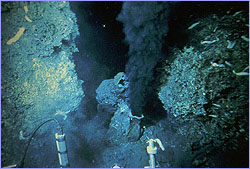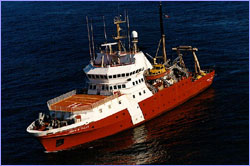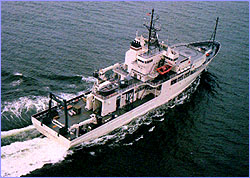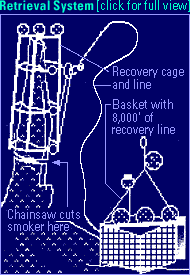
|

|

|
Birth of an Expedition
Part 2
(back to Part 1)
An expedition is born
Then
John Delaney,
the co-leader of this expedition, had a brainstorm. Why not
retrieve a black smoker or two off the seabed? Sure, the flow
of superheated chemicals would stop and the attendant life
forms would quickly perish when brought to the surface. But
geologists could study how the chimneys grow, how fluids flow
through them, and what role microbial life plays in their
evolution. And biologists could be standing by as the smoker
came up to examine the life forms, everything from the
chemical-eating microbes to the giant tubeworms.
|
 Black smoker photographed from submersible.
Black smoker photographed from submersible.
|
Delaney, a geologist at the University of Washington,
convinced his colleague and friend, geologist
Edmond A. Mathez
of the American Museum of Natural History, of the significance
of this attempt, and an expedition was born. Their two
institutions are collaborating in the effort.
The University of Washington
is focusing on research and science education, while
the American Museum
is hoping to increase public understanding of this unusual
world by acquiring a black smoker for its new Hall of the
Planet Earth, slated to open in summer 1999.
Delaney knew exactly where he'd go for a black smoker. In
1982, one of the most impressive sites for black smokers was
discovered practically in his backyard: on the Endeavour
Segment of the Juan de Fuca Ridge. The Juan de Fuca, part of
the 46,000-mile mid-ocean ridge that zippers the globe, is a
spreading center, where new seafloor is created. And the
Endeavor Segment hosts one of the most vigorous hydrothermal
systems yet identified. It features at least four major,
high-temperature vent fields, each about 1,000 feet on a side,
with whole forests of black smokers crawling with red-tipped
tubeworms, gangly white crabs, and the like.
|
 Godzilla, the largest black smoker yet identified.
Godzilla, the largest black smoker yet identified.
|
The expedition began in September 1997 with a "site
characterization" cruise to the Endeavour Segment. Delaney and
colleagues used the remotely operated vehicle Jason, equipped
with acoustic and optical imaging systems, to minutely
photograph and map several target black smokers. They showed
that these geysers can grow up to an inch or so a day and can
collapse of their own weight; Godzilla, a smoker some 14
stories tall, did so a few years back. The targeted smokers
are more modest, the biggest one about 10 feet tall and
weighing some 15,000 pounds.
Going after a smoker
On June 25, 1998, the oceanographic research vessel Thomas G.
Thompson will head out to the Endeavor Segment from Seattle in
an attempt to realize Mathez and Delaney's dream. This time,
no manned submersible will be used. Instead, the researchers
will use the aforementioned remotely operated vehicle. It's
called
ROPOS, for
Remotely Operated Platform for Ocean Science. This robot is
tethered to the ship with cable, through which images from its
on-board cameras and other data can be sent along in
real-time.
Piloted by Shepherd, ROPOS will first examine and photograph
the black smoker, for before-and-after studies. It will then
cinch wire loops tightly around it. These cables are attached
to an 8,000-foot-long line coming off a 30,000-pound winch on
the deck of the Canadian Coast Guard research vessel John P.
Tully, which will perform the actual recovery. ROPOS will then
use a hydraulic, diamond-embedded chain saw to cut notches in
the base of the smoking chimney, just as foresters do when
cutting down trees. Only when the robot is well out of the way
will engineers aboard the Tully take the slack out of the
cable to the surface and apply full force to the winch.
Nobody knows what will happen then. The hope is that the black
smoker will break free cleanly and be brought in one piece to
the surface. But this has never been tried before. Will the
smoker stump explode? Will the smoker itself break apart? What
will happen in the immediate vicinity of the smoker? Will
engineer
Le Olson
succeed in lifting it to the surface? What effect will the
change in pressure and temperature have on it?
|
 Canadian Coast Guard ship John P. Tully.
Canadian Coast Guard ship John P. Tully.
|
If the team succeeds and manages to hoist a steaming,
seven-and-half-ton smoker onto the Tully, geologist
Deborah Kelley
and her team take over. They will use a diamond-embedded wire
saw to slice the smoker in half. One half will be set aside
for the American Museum; the other half will immediately
undergo intensive study by a crew of microbiologists, fluid
chemists, mineralogists, and marine scientists. The Thompson
will remain behind to gauge the aftermath of the retrieval.
Will the stump regrow? Will wildlife recolonize it, and if so,
how quickly?
 The R/V Thomas G. Thompson.
The R/V Thomas G. Thompson.
|
|
Bookmark this site to follow the course of this
ground-breaking expedition to the bottom of the sea—a
mission that might hold clues to the very beginnings of life
on Earth, if not elsewhere in the solar system.
Peter Tyson is Online Producer of NOVA.
Birth of an Expedition
|
Mission Plan
| Dispatches
Through the Porthole
|
Meet the Team
Meet ROPOS
(JavaScript/Frames-capable browser required)
Meet ROPOS (No Frames/JavaScript)
Photos: (1-2) NOAA/Pacific Marine Environmental Laboratory;
(3) © Woods Hole Oceanographic Institution/Dr. Robert
Hessler; (4) Dimitry Schidlovsky; (5) V. Tunnicliffe; (6)
Visuals Unlimited/© WHOI/D. Foster; (7) D. Kelley; (8)
V. Robigou; (9) Fisheries and Oceans/Canada; (10) University
of Washington; (11) Marine Operations, UW School of
Oceanography.
The Mission |
Life in the Abyss |
The Last Frontier |
Dispatches
E-mail |
Resources |
Table of Contents
|
Abyss Home
Editor's Picks
|
Previous Sites
|
Join Us/E-mail
|
TV/Web Schedule
About NOVA |
Teachers |
Site Map |
Shop |
Jobs |
Search |
To print
PBS Online |
NOVA Online |
WGBH
©
| Updated October 2000
|
|
|



 Black smoker photographed from submersible.
Black smoker photographed from submersible.

 Godzilla, the largest black smoker yet identified.
Godzilla, the largest black smoker yet identified.

 Canadian Coast Guard ship John P. Tully.
Canadian Coast Guard ship John P. Tully.
 The R/V Thomas G. Thompson.
The R/V Thomas G. Thompson.